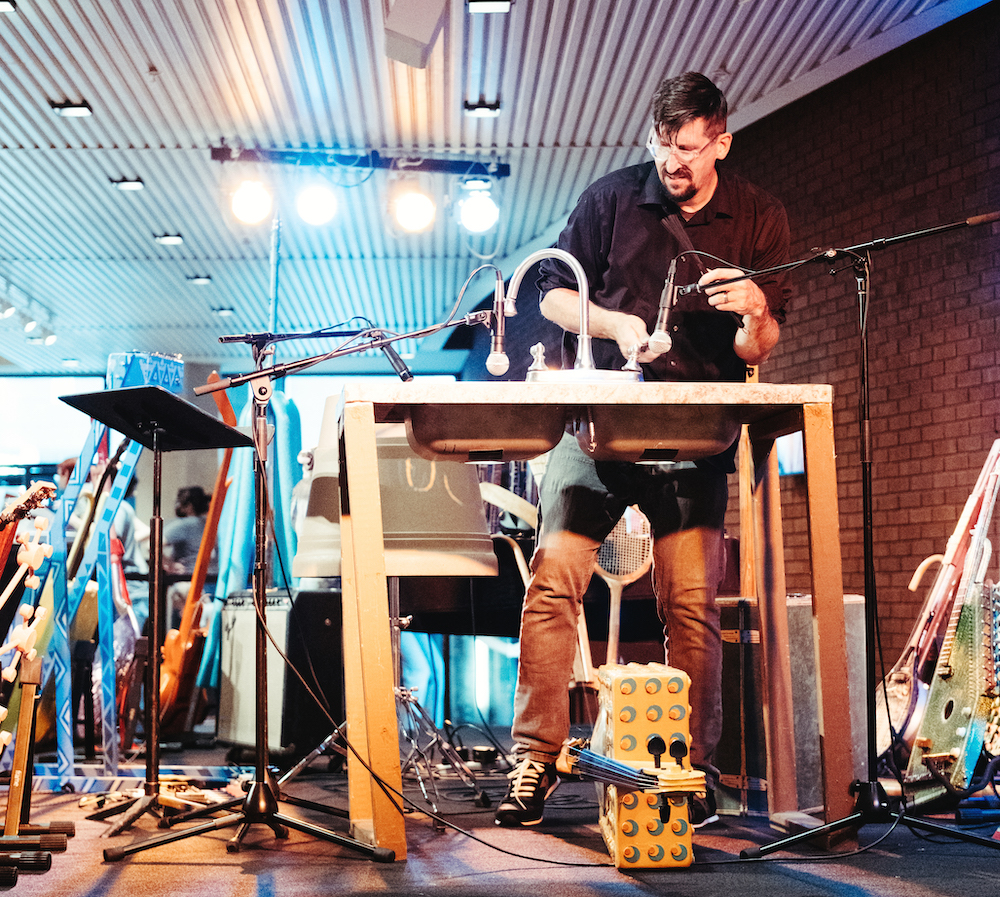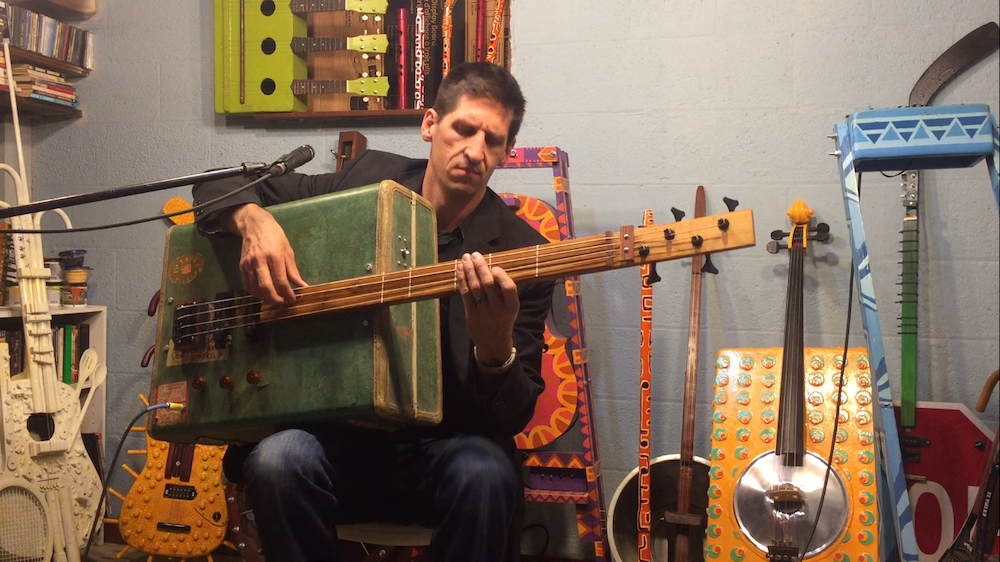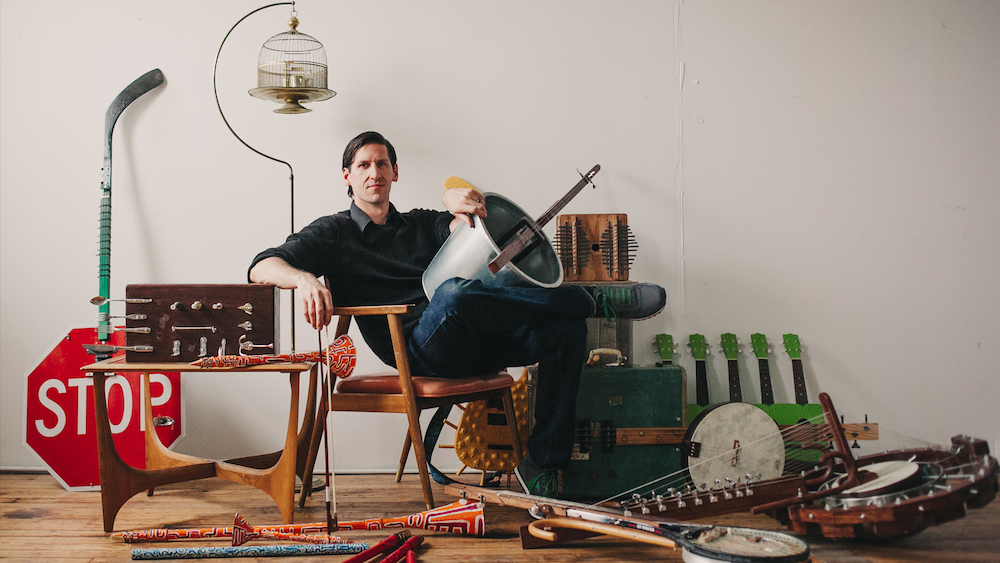“This has never worked. But if it does, you’ll know it. If it doesn’t, you’ll know that too.”
Joe Rauen is on Krannert’s stage five, holding in his right hand a battery-operated power drill. On his left, is one of his examples of objet trouve. It’s a sparkling, silver guitar made from something resembling a frying pan. Or, does it? The fingerboard is light wood and of what appears to be very short scale. The longer the eye plays on this thing, the less apparent is its origin and use. That will be demonstrated soon enough.
This instrument is, by comparison, the most sedate in the appearance of the instruments — not immediately recognized as such — that occupy the stage. In actual fact, until the sound is produced the viewer might assume that the stage is full of purely visual art. There are bright hues of sea-green, cobalt blue, silver, dark red, black, and school bus yellow. Further, the instruments on stage seem to resemble pastiches of non-musical items: canes, shovels, suitcases, hockey sticks, tennis rackets, PVC pipe, bolts, screws. The mind leaps to a cliche describing variety and sheer numbers. In what appears to be endemic drollery, there is the presence of a kitchen sink at the back of stage left.
Rauen is a Berkley College Of Music trained composer and musician who seems to understand how to converge various modes of expression into a single stream. He sees potential for art and music in everyday household items and various trade implements. The process is random, yet linear. Rauen may happen on something in a hardware store, but instead of seeing its intended use, he may see a banjo. This is reminiscent of what we all did as kids: imaginative play. We remember how great it was.
He successfully combines visual art sensibility with the craft of instrument building and a natural tendency toward performance. But, there’s a key element to Rauen and his work that’s apparently either not a priority with other artists or is often not achieved. This is the direct extension of the artist’s pure self conveyed without obvious technical emphasis. The viewer might recall miming with a tennis racket to favored music, and later learn that it was during this, that true inspiration occurs. You can, because you don’t know that you can’t. Rauen understands that technique is not the goal, but a means to reach it. His good humor, generosity, and fierce inventiveness come through during his performance.

Image by Anna Longworth.
And so it is, that Joe brings his own bag of tricks (an apt description) to Stage 5 in the lobby of Krannert. At six p.m., the odyssey begins. The supply of chairs quickly runs dry, and many are forced or choose to stand.
When confronting the stage, the audience sees a herd of colorful instruments arranged not in regards to conventional stage-craft, but in the way of a friend showing off his beloved collection. There is a bass guitar made from an old suitcase. There’s a zalimba atop a homemade stand painted in a blue and white swirl pattern. There are shovel guitars and multi-woodwind instruments. He has a multi-necked ukelele, and an autoharp sitar. Rauen has built an instrument “out of a coach’s closet” — canes a broom and a hockey stick. The eccentricity of the instruments themselves is redolent and subsumed by Joe Rauen’s music and personality.
Since the act is a “one-man show,’ Rauen employs an electronic looping machine that allows him to record one musical figure, then have it repeated at the step of a footswitch until such time as he decides to stop it or start it again. It’s a live-action imitation of sound on sound recording. He can then layer up to six or even nine other figures over the original “loop” to gradually make the harmonic texture denser, or fill the sonic spectrum. So, rather than a sound of chords changing, the effect might be analyzed as a passacaglia — a piece that continually builds as it cycles through. A steady beat is primal and appeals to the human need for meditative states. Rauen’s music grooves. He begins with a song called, “You Are The Cactus.”
What’s apparent in Rauen’s craft is a reflexive understanding of genre guide-posts and stylistic wit. Musical jokes — if they can be so named — are interspersed throughout the improvisation forays. These are seen to have the presumably desired effect, as the audience reacted receptively to them in recognition. Joe’s wit on stage is as sharp as his designs. When a performer is verbally conversational, it relaxes the audience and importunes a playful atmosphere.

Image borrowed from Joe Rauen’s website.
There is a kind of Public Broadcasting flavor to both the show and its audience. With Rauen, this moves farther. His demeanor on stage isone of a friend randomly choosing curiosities to show to some visitor. The viewer is captivated by infectious enthusiasm and rapid-fire comedic brainstorming. He squeezed much into the tight thirty minutes that was allocated for this, the first of two shows. Lost in the stream of performance, Rauen used up all but two minutes of his time slot.
“I’d better do something really cool,” and he did.
Joe was gracious enough to grant an interview with SP as well as chat with audience members after the show. Join us as we learn more about this dynamic artist and performer.
Smile Politely: The fecundity and generatively rich variance of your designs are most impressive. Is there an inspirational interplay between the ergonomics or purpose of a given object and how you develop its composition?
Joe Rauen: My thesis is that the instruments we play shape how we play them. Sometimes in obvious ways and sometimes in subtle ways. I make unfamiliar instruments from familiar parts to see how these new instruments behave and what they inspire me to play. Most of my instruments have bad ergonomics: they are too heavy, they have places that are hard to reach or force me to use unconventional techniques. These limitations can be very inspiring though because I have to think creatively about how to get around them. Every instrument I have made has something it does really well and the magic is in finding it and using it in a way that resonates with the audience.
SP: Your training at a world-renown music school is well-documented. And, your technical facility with visual art forms is also apparent. Was there an endemic encouragement or team of influencers who fostered a cross-disciplinary approach in you?
Rauen: That came more from me than from studying at the Berklee College of Music. Berklee is like a conservatory; it’s just music. There were lots of majors but ultimately everyone there was studying music. It wasn’t like a place where you could study ceramics or painting, or something like that and try to blend it with music. I had a sense then that studying music was going to be necessary but not sufficient. Even then I was trying to come up with a way to use instruments differently and to incorporate visual art, design, different things I was interested in. I had a concept in mind but I didn’t have the big picture. I accepted that I was going to have to experiment and maybe have a few false starts before I figured what a real cross-disciplinary approach would be like.
SP: What is your order of operation? Does the parent object call the music? Does the music inspire the visual?
Rauen: It happens in lots of ways, but a common way is that I see some object that inspires me and makes me think it would make a good musical instrument. Sometimes that object lays dormant until I get the next piece of the puzzle and I see how the two items complement each other. Sometimes I think about what’s missing from my arsenal and try to find just the right piece to make an instrument that fills the gap. The music always comes second. Once I have the instrument mostly complete I start finding out what its personality is like. Once in a while, an instrument will be very forthcoming and show me exactly what it does well. More often I find it gradually by playing it and seeing where inspiration takes me.
SP: You’re an accomplished multi-instrumentalist and trained composer. Does your scrupulous attention to innovation extend to music composition ideas, also?
Rauen: I wouldn’t say my compositions are particularly innovative. Part of the fun is that I make these instruments, a shovel guitar for example, and If I play it effectively you might forget for a moment that you’re listening to a shovel. That push and pull between the familiar and the unusual is the sign to me that it’s working. There is also a significant amount of improvisation and that can depend on what the audience is like. If an audience is skeptical or indifferent then I need to bring them along with me. If an audience is receptive right from the start I can take bigger risks, improvisationally, and those can be very rewarding.
SP: In modern times, the misfit has become the majority, which seems to have more or less devalued eccentricity. Do you feel this advances creativity or constitutes impediments for the individual? Could it desensitize the public to projects such as yours?
Rauen: I have a strong suspicion that most performers see themselves as misfits of one kind or another. This is like that George Bernand Shaw line about all progress being dependent on the unreasonable man. I don’t think you’d want to get up on stage and look everyone in the eye unless you had something driving you to do it. I don’t know about the whole music listening public, but the people I meet tend to get right away that it’s about an abundance of creativity. I’m not content to just play the music; I want to compose the music and design the instrument, build it, and hide little surprises throughout the whole process. I think people are sensitive enough to get that it’s all kind of a riff on creativity itself.
SP: How was the reception to your endeavors in Boston? Did you encounter any opposition or dismissiveness in academic circles?
Rauen: I didn’t build any instruments while I was going to school in Boston. I did experiment with different tunings and things like that. I also listened to a lot of musicians who used instruments in unique ways: Rahsaan Roland Kirk who played multiple saxophones at once, Stanley Jordan who plays guitar by tapping, Gideon Freudman who uses the cello and looping to make a one-man show. The people I stay in touch with from Berklee really like what I’m doing so I think that bodes well.
SP: Since each of your projects seems to be a pocket art movement unto itself, it’s hard to detect any linear evolution. How do your early efforts compare to more recent pieces?
Rauen: The instruments are definitely getting more ambitious. Bigger, more advanced electronics, more intricately painted, more covered in odd brick-a-brak. I’ve gotten slightly more skilled with the tools required, so the newer ones are more likely to have metal-work, or bent wood, or more sophisticated joinery. Now that I have a number of pieces that work reliably I feel more included to take chances; I like when each instrument is different in some way from the previous ones. I also think more now about what wouldn’t you do if you were making an instrument. Thinking like that led me to the guitar with the giant hole in the middle which is always a crowd-pleaser.
SP: When combining media in extreme ways, there is often a kind of whimsy that results. Does your work or its inspiration ever take a dark or serious tone?
Rauen: Whimsical is a good word. I like it. The instruments I make are supposed to be fun and imaginative. There’s humor too; in the instruments and in the way they get used on stage and in the way I communicate to the audience. I leave it up to the listener to decide what’s funny and what’s serious. I get up on stage and do my best to communicate something to the people in the room. But they make up half the equation. They bring their own aesthetic and taste and life experience, and ultimately they have to do their own sense-making about what it all means.
SP:Is your musical output notated? Does a “Joe Rauen Songbook” or method book exist for others who will no doubt feel your influence?
Rauen: I do notate my pieces. Usually, it’s a kind of musical to-do list so I don’t forget what the important elements of a piece are. Also, I try to keep track of what instruments I’m going to use for each piece so I can make sure they’re all close by when I start. I try not to do too many pieces that start or end the same way in a row. And I try to keep the instruments rotating so it’s not all tennis racquet banjo at the start of the show and none at the end. I use a pretty wide variety of notations. Music on a staff in treble or bass clef, chord symbols, descriptive terms, sometimes TAB if it’s important for a part to be played on certain strings. Sometimes I draw little pictures or shapes, or color code words. I don’t think anyone would want to have it as a songbook. I think to anyone but me it would look like the shopping list of a maniac.
SP: What ideas or projects are you developing now that maybe stand apart from your current and past canon?
Rauen: I would like to go to places around the world and play music with the people I meet. I have a shortlist of countries in mind where I think that would be really productive. I have an especially deep love for a kind of music that comes from Southern India called Carnatic Music. There’s an annual Carnatic music festival in Chennai, India and I’d like to go there and be a part of it. I give myself ten years on that one.
Check out Joe Rauen’s website here to learn more about him and his work.








